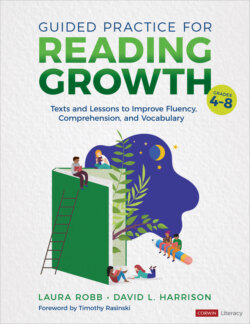Читать книгу Guided Practice for Reading Growth, Grades 4-8 - Laura Robb - Страница 24
На сайте Литреса книга снята с продажи.
Skilled Teachers Take Notes to Help Differentiate Instruction
ОглавлениеEarly in my teaching career, I learned the importance of jotting notes to record my observations of students during daily interactive read-alouds and while students work independently, with a partner, or with me in a small group. Notes became my memory, and in conjunction with students’ notebook writing, they offered information about students’ progress. Notes help you make informed decisions about the instruction your students need, allowing you to differentiate with more confidence and impact. Moreover, notes can support recommendations during IEP (individual educational plans) meetings. Here are some tips for streamlining and organizing daily notes.
Notice and note: Place dated sticky notes on several sheets of blank paper and attach to a clipboard. Avoid editorializing and keep notes as objective as possible because you’ll frequently find yourself sharing your notes with students during conferences. Figure 1.4 is an example of my notes for students after a guided practice lesson. Notice how I jot positives in addition to areas needing support. I do this to help students notice small increments of progress that they don’t always see.DescriptionFigure 1.4: Robb’s notes after guided practice always highlight what’s working, and she raises one point to reflect on for possible intervention.
Storing daily notes: At the end of each day, transfer your notes into a loose-leaf binder or Google doc. Use dividers to separate the ELA sections you teach. In each section, note a student’s name on about three sheets of paper—you can add more once you’ve filled the front and back of each sheet.
While working with developing readers, the temptation to move from mini-lessons to reading books is powerful. However, I have learned that it’s best to slow down and invest in guided practice, so students can develop skill applying a strategy you’ve modeled during a mini-lesson. Having time to practice can improve students reading, writing, and discussions.
Teaching Tip
Set aside time, every two to three weeks, to review the notes for each student. Start with students who aren’t making enough progress and see if your notes offer clues for moving that child forward. For example, I noticed that fifth grader Jaylinda’s poetry reading, at the end of each week, wasn’t fluent and expressive, even though there was time for daily practice with a partner. A review of my notes revealed she had not read her poem to her partner during the last two weeks. Instead of making this a behavior issue, I observed Jaylinda and her partner every day for a week. When her fluency and expression improved, I conferred with her and discussed the benefits of daily practice. Having the notes pinpointed the issue and enabled me to design a positive intervention instead of calling attention to what she wasn’t doing and risk enlarging her frustration and anger.
